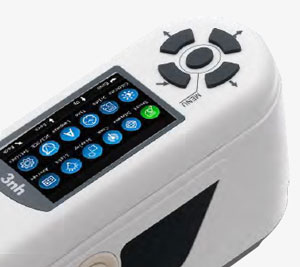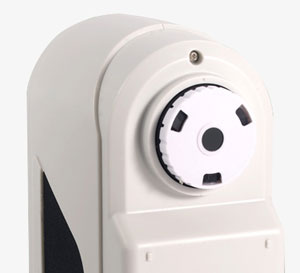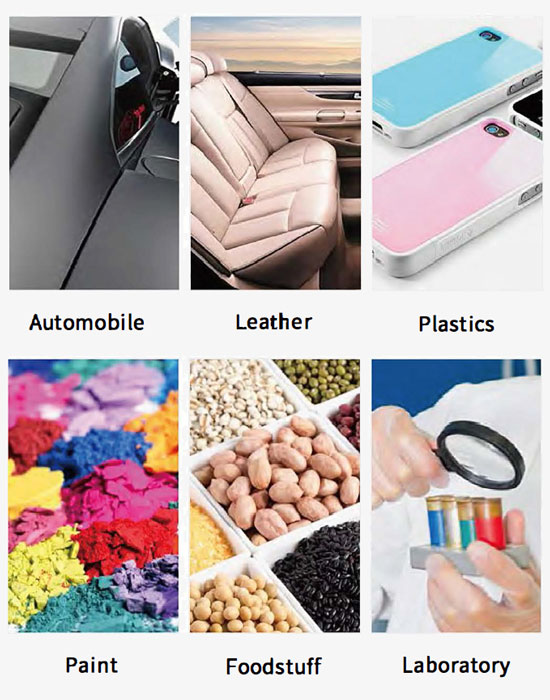The laboratory colormeter has a stable measurement performance, the OE fluctuation is less than 0.06. on average, portable structure design is more conducive to keeping the body stable during application.

Humanized design and ease of operation
- The automatic black and white board correction function ensures high accuracy of the lab colorimeter.
- Ergonomic structure design provides comfortable operation for long-term use of the pocket colormeter.

Long battery life
- The sisco colorimeter uses a high-capacity lithium-ion battery that can be recharged repeatedly.
- Charging once can be measured more than 300 times, to ensure the stability of long time multiple measurements.
Application
The colorimeter can easily achieve accurate color transmission and can also be used as precision color testing equipment. It is widely used in plastic, electronics, paint, ink, textile and garment, printing and dyeing, printing paper, automotive, medical, cosmetic and food industries, research institutes, schools and laboratories.
| Model | SISCO-CM-NH310 |
| Illuminating/Viewing Geometry | 8/d |
| Measuring Aperture | φ8mm/φ4mm |
| Errors Between Each Equipment | ≤0.40 E*ab |
| Repeatability | Standard deviation within E *ab 0.06, Average of 30 measurements of, standard white plate |
| Detector | Silicon photoelectric diode |
| Locating | Illuminating Locating/Cross Locating |
| Measurement End Face | Large stable end-face and small concave-convex end-face |
| Color Space | CIEL*a*b*C*h* CIEL*a*b* CIEXYZ CIERGB CIEL*u*v* CIEL*C*h Yellowness & Whiteness Color Fastness |
| Measuring Times Before Recharging | More than 3000 times |
| Light Source | D65, D50 A |
| Light Source Device | LED blue light excitation |
| Weight | 500g |
| Power source | Rechargeable lithium-ion battery 3.7V@3200mAh |
| Lamp Life | 5 years, more than 1.6 million measurements |
| Charging Time | 2 hours (first time 8 hours--100% electricity) |
| Connector | USB |
| Operating Environment | 0~40℃, 0~85%RH (no condensing), Altitude<2000m |
| Dimension | 205×70×100mm |
Note: The user can perform black-and-white calibration through the standard black-and-white box of the instrument and refer to the user manual to complete the calibration independently.
Packing List
- 1 x Colorimeter
- 1 x Power adapter
- 1 x Manual
- 1 x Quality management software
- 1 x Data cable
- 1 x Whiteboard box
- 1 x Φ8 measuring diameter
- 1 x Φ4 measuring diameter
- 1 x Lithium battery
Q1: How does a colorimeter work?
A1: Colorimeters rely on the concept of the Beer-Lambert law, which assumes that the absorbance of a substance is proportional to its concentration. For example, the higher the concentration of a solution, the higher the absorbance reading. Many chemical and biological experiments are based on this concept. To obtain a Beer's law curve, several standards (solutions of known concentration) are prepared and their absorbance values are determined using a colorimeter.
Q2: What is colorimetry?
A2: A colorimeter is a device that measures light absorbance (how much light is absorbed) and light transmission (how much light passes through) in a liquid by analyzing the intensity of the color.
Q3: What are the limitations of a colorimeter?
A3: One limitation of chemical colorimeters is that differences in certain substances may lead to inaccurate test results. According to Global Water Instrumentation, because these differences are different for each substance, a chemical colorimeter alone is not a completely foolproof testing device.
Tips: The working principle of pocket colorimeter
Pocket colorimeter determines the color parameters of a sample by detecting its spectral composition, which not only gives the absolute values of X, Y, and Z and the color difference delta E, but also gives the spectral reflectance value of the object and yields the color spectral reflectance curve of the object. Therefore, it is widely used for color matching and color analysis.
High-precision color difference measurement can be achieved using a spectrometer, and a photoelectric integral colorimeter can be calibrated to establish colorimetric standards. Therefore, the spectrometer is the authoritative instrument for color measurement. There are two types of measurement observation: "0/45 degree" and "d/8 degree integrating sphere", where "0/45 degree" means that the light source is directed from a 45° angle and the 0° angle is used for color difference measurement. Can only be used to measure smooth surfaces, and can not be used for computer color matching. d / 8 degrees sphere can be used to measure a variety of surfaces, and can be used for computer color matching.
Thank you for buying industrial test and measurement equipment on SISCO.com, all products sold by SISCO and the partner cover a 12 months warranty, effective from the date of receiving the products.
What is covered?
SISCO is responsible for providing free spare parts, and free technical support to assist the customer to repair the defective products until the problem is solved.
What is not covered?
- Product purchased from anyone other than a SISCO store or a SISCO authorized reseller.
- Expendable parts.
- Routine cleaning or normal cosmetic and mechanical wear.
- Damage from misuse, abuse or neglect.
- Damage from use of parts other than SISCO approved.
- Damage from use outside the product’s usage or storage parameters.
- Damage from use of parts not sold by SISCO.
- Damage from modification or incorporation into other products.
- Damage from repair or replacement of warranted parts by a service provider other than a SISCO authorized service provider.
- Damage caused by the application environment not meeting the product usage requirements and the failure to perform preventive maintenance.

